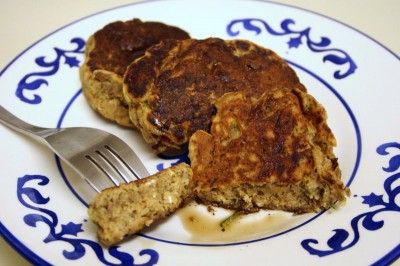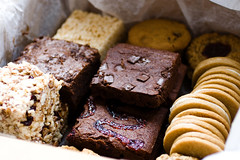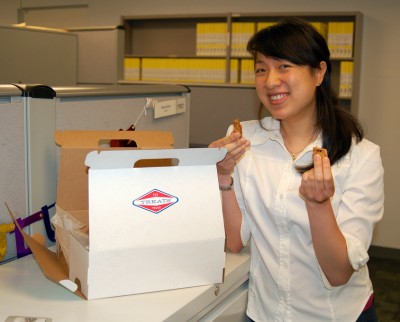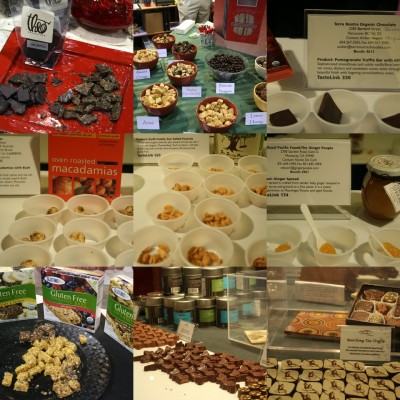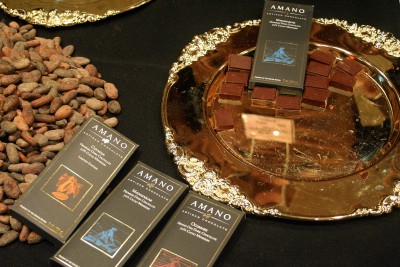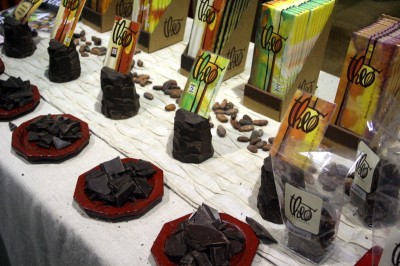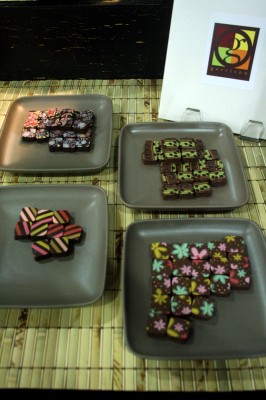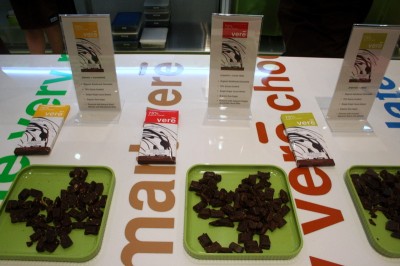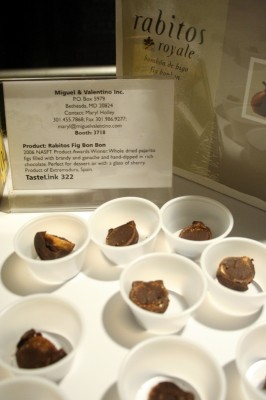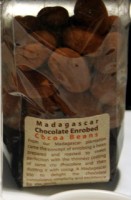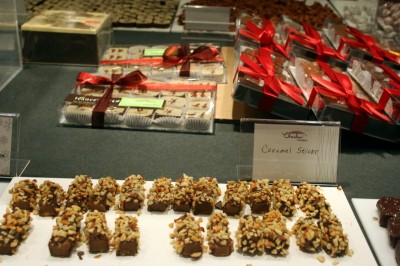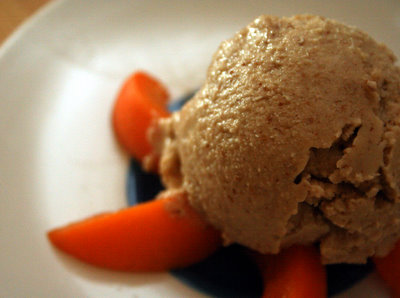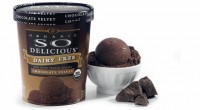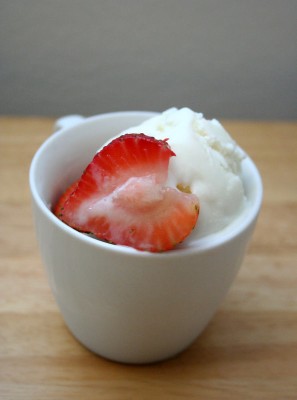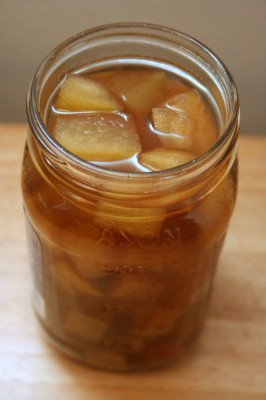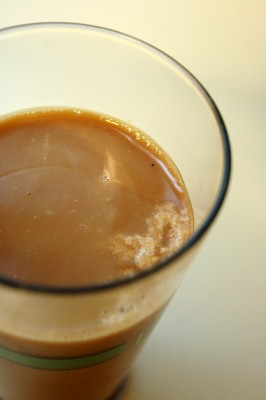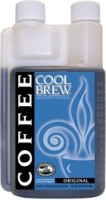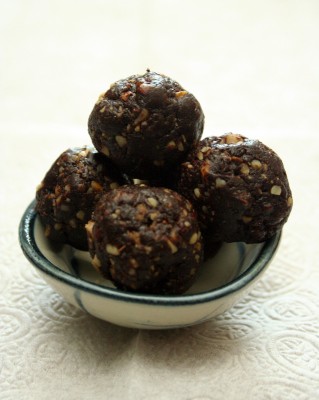For the past two weeks, I’ve been processing some heavy stuff from my food-oriented trip to New Orleans. First, I need to get the loom and gloom out of my system, and then I’ll move on to brighter subjects. I promise!
The CulinaryCorps team after two sweaty days in an outdoor kitchen. (Photo courtesy Gerald San Jose)
It was supposed to be a primer on jambalaya and king cake. Instead, a writing assignment led me to one of the hardest yet most rewarding experiences of my life.
In January, a food editor asked me to write an article on Hurricane Katrina victims who were celebrating Mardi Gras out of state. As I interviewed my subjects, I found that they couldn’t talk about their biggest joy of the year without mentioning the biggest tragedy of their lives. There was Kevin Goodman, a Mardi Gras Indian who survived at the Morial Convention Center with hardly any food or water. He saw diabetics and wheelchair-bound people die prematurely. He saw others kill each other. Now settled in Austin, Texas, he doesn’t plan on returning to the place he once called home.
And no matter how hard Mary Prater, a student-teacher who relocated to Indianapolis, explained the importance of the Mardi Gras Zulu coconut, I remained clueless.
When Fred Sullivan told me about his plan to celebrate with a crawfish boil in his new home in Florida, I was intrigued. But I didn’t see how eating with your hands over soggy newspaper was a fine dining experience.
The article sparked an interest in New Orleans. So when fellow food blogger Gerald San Jose told me about a New Orleans CulinaryCorps (like Peace Corps for cooks) trip, I immediately signed up. When I volunteered from June 1 to 8, I finally saw the sparkling, beaded Mardi Gras costumes and experienced not one, but two crawfish boils in all their glorious mess.
I also saw heartbreaking living conditions. I had been warned: It will be hot. It will be dirty. You will work 16-hour days. You will tour mold-infested houses. However, nothing could prepare me for the Lower Ninth Ward, one of the hardest hit areas of the storm.
Ashley Graham of Share Our Strength gives a tour of the Lower Ninth Ward. All the grass is where houses used to stand.
Walking through the French Quarter in New Orleans, you’d never know that a disaster struck. It’s business as usual, if not a little subdued. The Ninth Ward, however, has been neglected because it’s one of the city’s poorest neighborhoods.
The news describes Extreme Home Makeover-type rebuilding in New Orleans. In reality, it’s the exception to the rule in the Ninth Ward. An area that looked like the size of Manhattan was washed away. Except if such a thing happened in Manhattan, there’s no way it would remain in shambles after almost two years. In some areas, a couple concrete steps were the only clue that houses used to stand. People were still living in shoebox-sized FEMA trailers. Some streets were deserted except for one occupied house. Residents stubbornly stayed because they inherited the land from their family, and they had no where else to go.
During the week, my CulinaryCorps teammates and I cooked in several needy areas, including Emergency Communities, a recreation center offering free meals, laundry and Internet access. When we pulled up to the site in the Lower Ninth Ward, we were greeted by an overflowing dumpster and several trash bags on nearly toxic ground. Forget recycling; they didn’t even have regular trash pick up. Within the first 10 minutes of arriving, I wanted to faint. I couldn’t tell whether it was the scorching heat, rotten food or heavy lifting.
The trash pile that greeted us at Emergency Communities. By the end of the day, there was no more room to put out another trash bag. (Photo: Mick Guzman)
The walk-in refrigerator had cooked meals dating back to April and cases of yellowing “green” onions. The freezer was an even bigger nightmare, with chicken that expired in February 2005. Emergency Communities just served it three days earlier because they had nothing better for the residents. The refrigerator and freezer were actually broken trucks that leaked an oil-coolant cocktail into the street.
For hours, I disposed of the green onions and other unmentionables. It didn’t matter how many times I wiped my sweat with hard-to-find paper towels; I was dripping from head to toe.
My teammates and I threw away an estimated 2,000 pounds of spoiled chicken after the freezer broke down. (Photo: Mick Guzman)
After restoring the fridge and freezer to a workable condition, I returned the next day and found fresh empty beer cans inside. Our leader Christine Carroll said that the first CulinaryCorps team in March cleaned up Emergency Communities, exactly like we did. Then it got dirtier than ever.
The conditions at Emergency Communities were worse than my experiences in rural Mexico, where a pack of soda was a week’s salary. In Mexico, people at least had access to clean food and water. My teammate Kim O’Donnel, who did relief work in AIDS-ravaged Zambia, said that even Africa was better.
Everything at Emergency Communities seemed hopeless, from the kitchen to the glassy-eyed residents who hobbled in for the meals. CulinaryCorps put in two days of hard work, but on-site volunteers are still working there for free. Twenty of them slept in a trailer a little larger than my one-bedroom apartment. They shared one outdoor shower converted from a Port-a-Potty. Two volunteers were “upgraded” to an abandoned house across the street. As the sun set, they sat on a dirty mattress, thankful for an extension cord that powered dim Christmas lights inside (their only source of electricity). No one should live like this, especially in America.
Two Emergency Communities volunteers “squat” in this house. (Photo: Mick Guzman)
Interior of the house. (Photo: Mick Guzman)
Inside the house of another volunteer, Darrin. (Photo: Erik Murnighan)
On our last day, we worked at Café Reconcile, which was supposed to be a beacon of hope. The full-fledged restaurant was run by at-risk teens who had no positive role models or were abandoned after Katrina (some schools still remain closed). A lot of the teens did marijuana since they were 10 or 12, but the vocational program instills confidence and gives them job skills. Customers crowded in during lunch to support the cause and sample their award-winning bread pudding.
Behind the public front, some of my colleagues were even more discouraged by Café Reconcile than Emergency Communities. Of the fifteen or so teens that enrolled, only four remained last week. Roger, the young man that I worked with, had exceptional knife skills, but he kept walking out every 10 minutes. During lunch service, he put his head down on the table in defeat as I fulfilled orders. In the meantime, teammate Courtney Knapp said she spent three hours scrubbing pre-Katrina dirt off the kitchen prep table.
It’s a miracle that anything got done in that chaotic kitchen. One of the directors quit after he was mugged at gunpoint, twice.
I want to believe that relief is in sight. Café Reconcile’s biggest success story is Oscar, a 17-year-old alum who now works at Emeril’s restaurant. The first lady was so impressed with him that he’s due to tour the White House.
After our intervention, Mark Weiner, the founder and executive director of Emergency Communities, promised to hire a kitchen enforcer. I can only hope that it’ll come to fruition and that our leftover meals aren’t still sitting in the refrigerator.
There’s also a new farmers market in the Ninth Ward, the only source of fresh produce for miles. The Holy Angels Farmers Market reported the best business ever after we held a brunch fundraiser. Granted, they were only four vendors in a church parking lot, but I want to believe… I need to believe.
Left to right: Vendor Heather Champagne (who made bread pudding with praline sauce), me, Kelli Wright-Morales and Kim O’Donnel serving brunch at the farmers market fundraiser. (Photo: Gerald San Jose)
If you are in any way moved, know that you can help.
- Pray for hope, volunteers and leadership in New Orleans.
- More than money, New Orleans needs skilled labor. All you need is a willing heart and an ability to follow directions. Try volunteering for these organizations.
- Donate to CulinaryCorps. Each member was given the challenge to raise $70. As of now, I’m at $0. Your money will go toward project partners such as Emergency Communities (to restock the infamous chicken), the farmers market and Edible Schoolyard (Chef Alice Waters’ culinary curriculum at the Samuel J. Green Charter School, where 95% of the students are at or below the poverty line).
- Vacation in New Orleans and pump money back into the economy. In the unlikely event that you run out of things to do, ask the friendly locals for suggestions.
For more info, check out these links:

